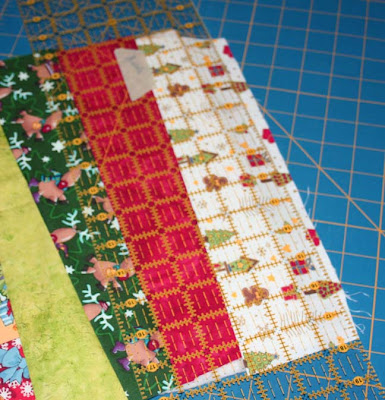You've seen our basic stocking pattern. Here are a few variations we think you'll love!
2. Wonky Pieced Stocking pattern
You will need:
(2) 12" x 20" pieces of batting
4-5 Christmas-themed fat quarters or fabric scraps to piece the stocking front (and back, if desired) Prints shown here are from the Santa's Workshop and Christmas 2012 collections, as well as the Marblehead collection.
3/4 yard of a Christmas-themed print for the lining
Basic sewing supplies
To piece the stocking front:
This stocking front uses batting as a foundation, and the strips are pieced directly onto it. Lay out a 12" x 20" piece of batting and cut your first two strips of fabric. Strips can range in width from as narrow as 1" to as wide as 4" and should measure about 12" long. Lay out the first strip near the bottom of the batting piece.
Lay the second strip on top, matching raw edges, with right sides together. Stitch using a 1/4" seam allowance.
Press the second strip up so it looks like this:
Now it's time to trim the second trip on a wonky angle. There are two ways to do this. You can flip the entire piece upside down and fold back the batting, as shown below. Position your ruler on a slight angle and trim ONLY the fabric strip just added.
Or, the second option is to leave the piece right side up and fold the batting away from under the just added strip. This way you can trim your strip while seeing the angles and widths of the strips below. The important part is to make sure you DON'T trim the batting too.
Here's an example of a wonkily trimmed strip. TIP: If your chosen fabrics have some busy prints, try mixing them with something calmer, like our Marblehead prints (see lime green below).
Whichever method you choose, after you've trimmed the strip, fold the batting back up and position your next strip against the raw edge of your trimmed strip. Repeat to add strips the entire length of the batting. Vary strip width and angle of wonky trimming for added interest.
You don't have to quilt the finished stocking top; the foundation method means that it is quilted already. But a nice finishing touch is to choose a contrasting thread color and topstitch 1/4" on both sides of each seam line.
Note: If you prefer not to do wonky piecing, use strips cut to the width you desire, and no trimming is necessary!
Layer the stocking template on your pieced stocking front and cut out out. You can either repeat for your stocking back, or just use a single piece of fabric, backed with batting. Follow the directions for our basic pattern to complete the stocking.
Note: Be sure that your stocking back, whether it's pieced or not, is a mirror image of your stocking front.
3. Diagonally "Pieced" Stocking
You will need:
(2) 12" x 20" pieces of batting
1 yard of Marblehead Metallic Xmas stripe
3/4 yard of a Marblehead Metallic Xmas print for the lining
Gold thread
Basic sewing supplies
To piece the stocking front:
Position the stocking template on the stripe, with the stripes running on a diagonal as shown.
Cut a loose shape around the stocking. Back this rectangle with batting, baste, and quilt along the diagonal lines. This helps create the illusion of piecing! Tip: Use gold thread to match the lines on the fabric. It doesn't have to be metallic, though--a gold colored thread works just fine and is easier than metallic!
Position the stocking shape on the quilted fabric and cut out.
Repeat for the the back side, making sure the stripe are oriented correctly and the stocking shape is a mirror image of the stocking front.
Follow the directions for our basic pattern to complete the stocking.
And one more variation we're providing for inspiration:
4. Checkerboard "Pieced" Stocking
You will need:
(2) 12" x 20" pieces of batting
3/4 yard of Marblehead Metallic Xmas stripe
3/4 yard of a Marblehead Metallic Xmas print for the lining
Gold thread
Basic sewing supplies
We'll just get you started with this one...
Cut 3" wide strips ACROSS the stripe.
You'll need strips of 6 squares each, but don't cut yet! Lay out your first row, and then position the remaining fabric below to make sure your have a fairly even distribution of color. Trim off extra squares.
Continue adding 6-square strips until you have 12-13 rows. Piece the rows together to create a checkerboard look, and then follow the directions for the diagonal stocking above--layer with batting, baste, and quilt on real and "faux" seam lines.
Have fun!
If you make one of these stockings, we'd love to see it! Send a photo to fabriquiltblog (at) gmail.com
And...we hope Santa fills your stockings with something besides coal!


















































